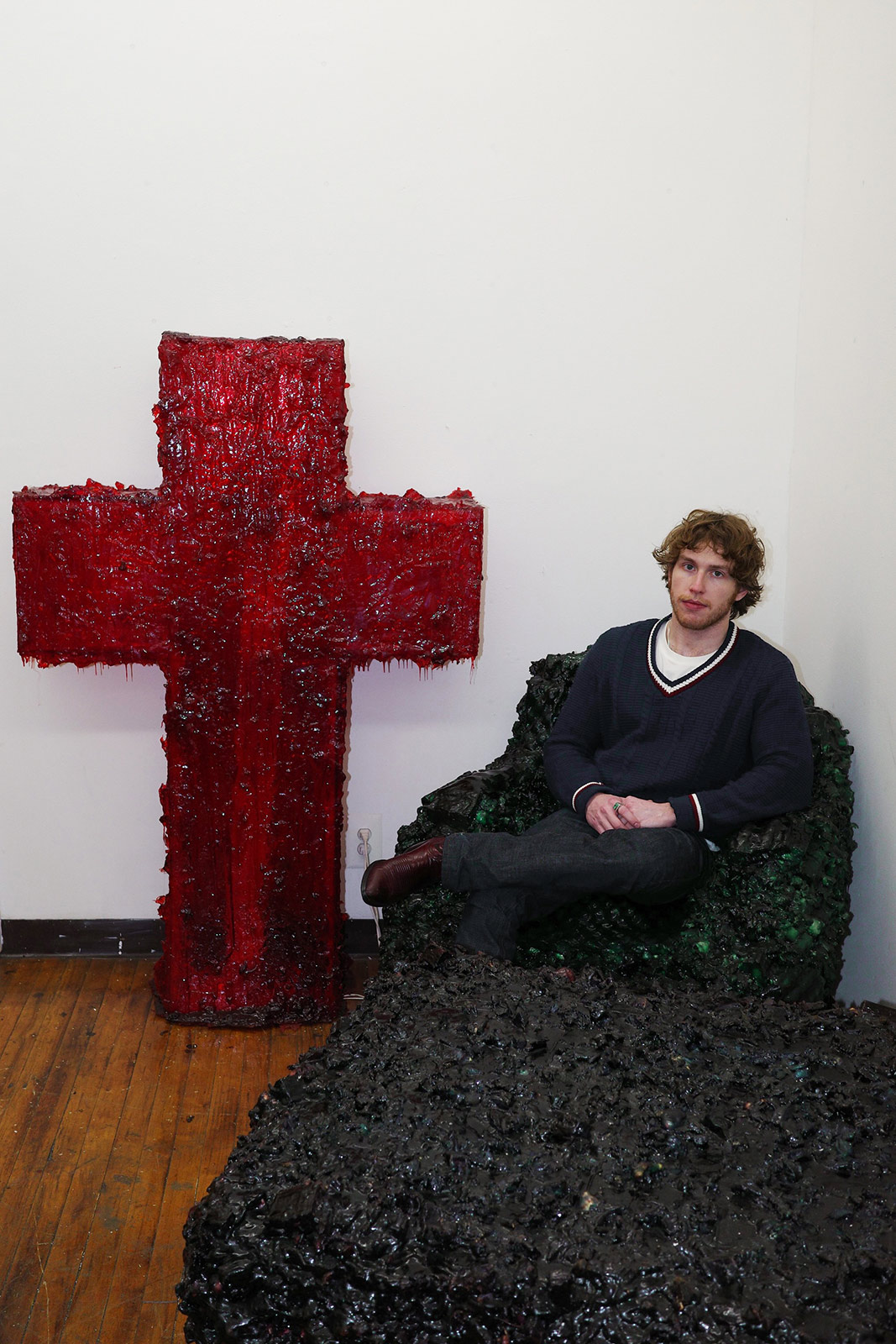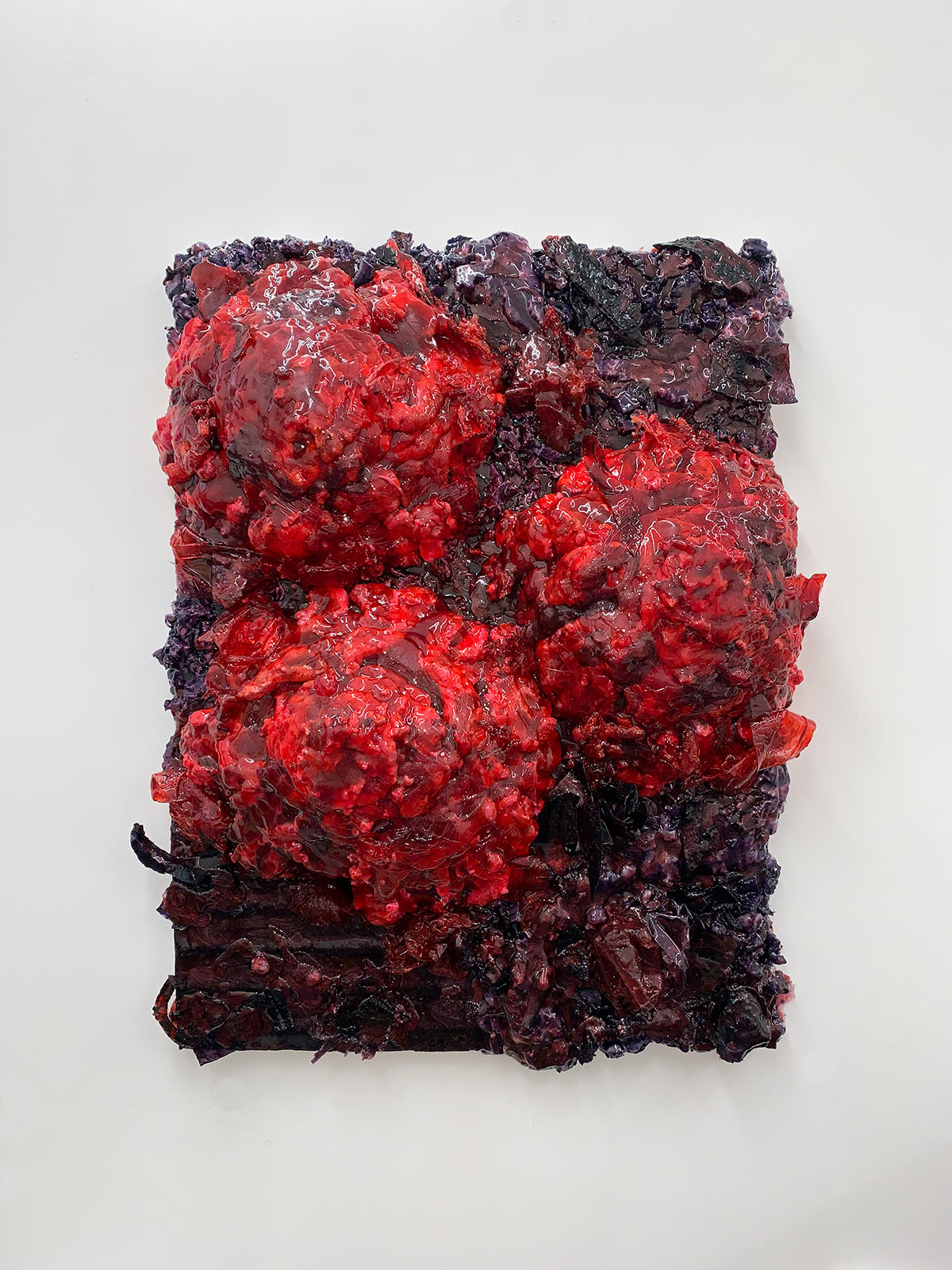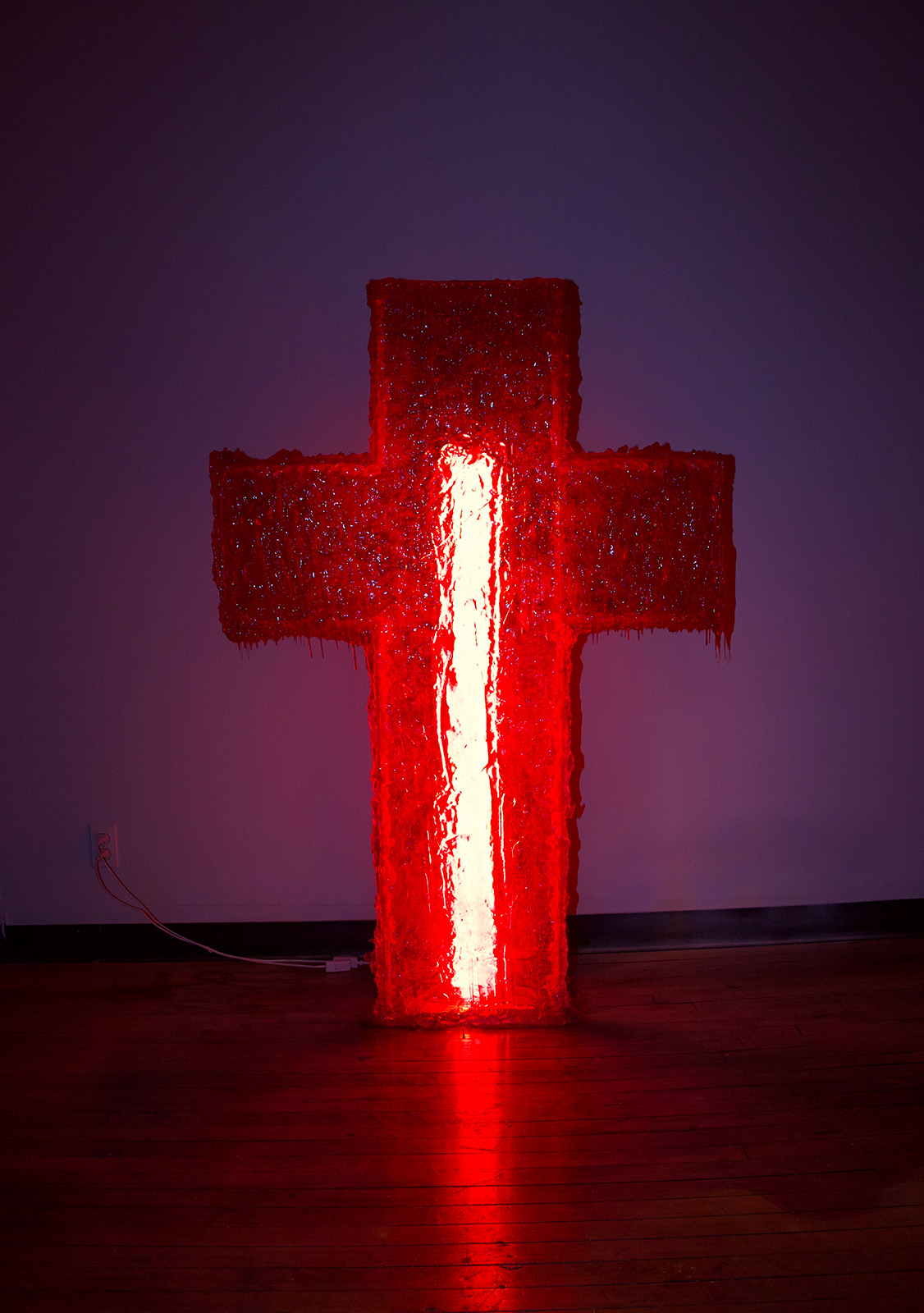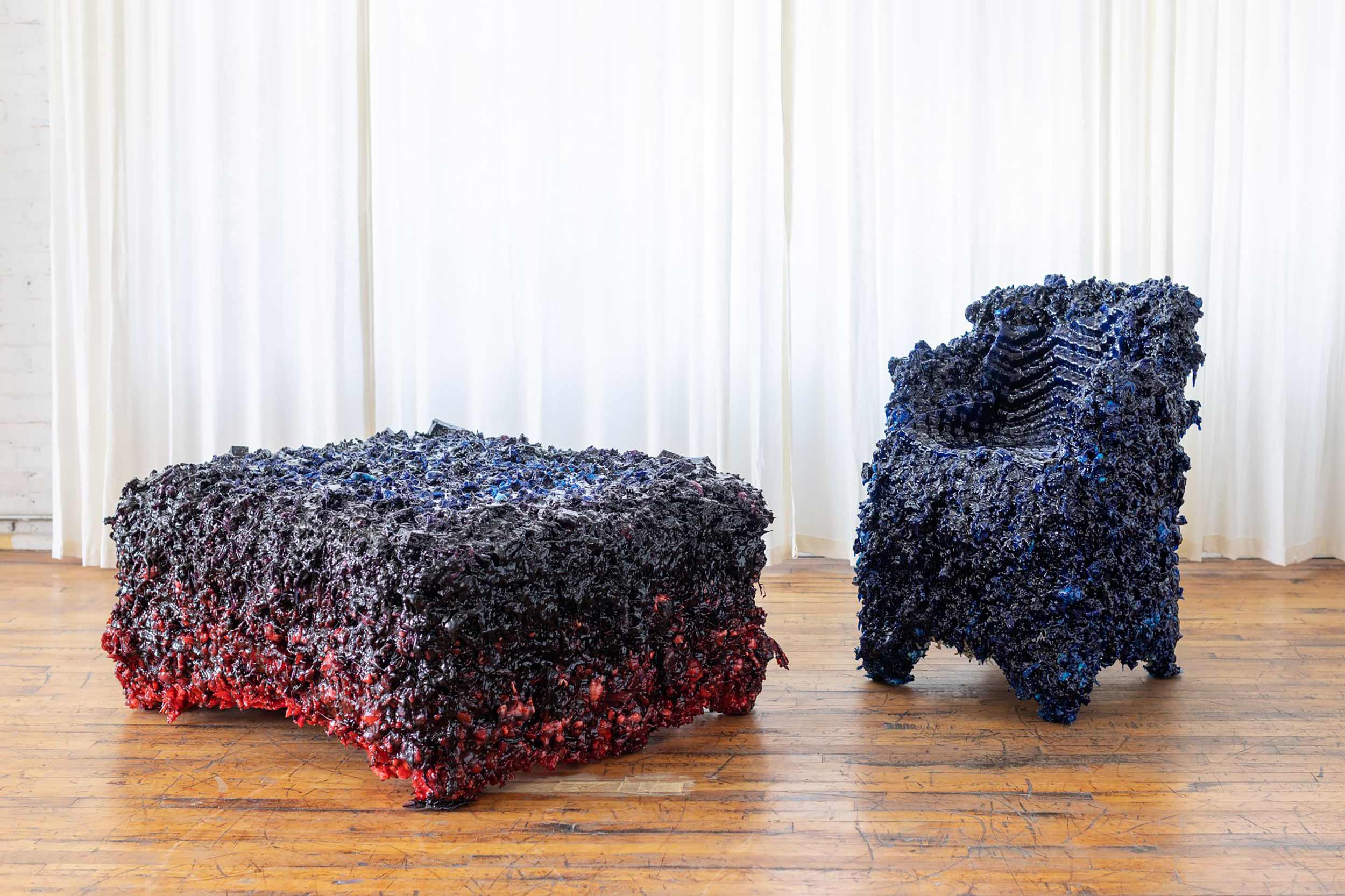
The New York-based artist joins Document to discuss faux-transgressive design, working-class fetishism, and the drive toward belief
In many ways, Noah Stalgia’s sculptural work is of the pandemic. The 25-year-old New York-based artist said that the collection of sculptural urethane rubber chairs for which he’s become known was created during the lockdowns. His artistic persona seems very much of the edgy downtown Manhattan art scene that emerged during that time. On a more metaphysical plane, the work seems otherworldly. Stalgia notes that his works have a “spiritual quality” as if they were guided by forces outside the known, buffeted by processes natural and unspeakable.
Stalgia was born outside of Detroit, where he obtained a traditional design education, working in the city’s remaining industrial facilities as an apprentice ironworker. He moved to New York in 2021 and has since become a fixture in the city’s Downtown avant garde, attending all those art shows and parties, as well as writing screeds filled with unbridled Id for Enzo the Magazine.
I meet the artist at his Bushwick studio, tucked into the warehouse district. The wind is blowing hard through the tall straight buildings, and somewhere up above in one of the defunct industrial ones, strobe lights are beating. There’s no one on the street, and I remember the rash of murders that had taken place near the clubs that fill the area. Soon a muscular arm beckons me inside, leading me through the surprisingly clean interior of the building. We sit and talk beside his work—the chairs and a series of crosses are pushed up against a nearby wall. There’s a small table, covered with materials and old magazines. He tells me that he doesn’t much like Brooklyn, and that he only goes there to work, preferring the stimulation and randomness of Manhattan. His manner is easy, if a bit suspicious and guarded. When he speaks he’s confident, his ideas fully formed. We talk about tradition and cringey transgressivism, faux working-class aesthetics, and his hands-on practice.
Ben Dreith: Your shift from furniture to more sculptural work happened around the same time you moved to New York from Detroit. Did the move itself prompt that shift?
Noah Stalgia: No, I’ve always known I didn’t want to do egalitarian furniture, furniture that was function over form. I [soon] realized it was of no interest to me. I lost interest in design quickly.
Ben: It’s hard to be an edgy designer these days.
Noah: Yeah, and I have nothing against being pretentious, but if you’re making a coffee maker, or a vacuum cleaner, or a chair that goes into an airport, there’s not much to pat yourself on the back for. How often is something truly being invented or reinvented? We’re working with all the same tools and mediums.
Ben: Mass production can be beautiful though. Would you like to see your work scaled up like that?
Noah: It’s never something I’ve thought about. I like making things with my own hands, and each thing comes out differently. If I were to make one hundred chairs that would be cool, but I would never want to design a chair [via] computer [program]. That doesn’t do anything for me.
Ben: What are you thinking about, consuming, when you plan these works?
Noah: I let things marinate for a long time, I let them stew. I don’t make any rough drafts or iterations of anything, I just make the real thing. And if it works, it works. If it doesn’t, I make something else. That process is rooted in my fascination with perverse things that aren’t of the norm, supermundane things. It’s hard to pinpoint what catches my eye, it could be a Corinne Day photo or it could be an article on [the history of] Laurel Canyon.
“It’s mind-boggling because I just did [those jobs] to pay for school. These guys are putting on Red Wing boots and Carhartt jackets to go and create an ad campaign for Soylent or something.”
Ben: It seems that a lot of people in your milieu are more interested in taking up symbols and working with what exists—these various traditions like Catholicism and glossy materials maybe even trashy things and trends as a way of sort of railing against the norm—as opposed to focusing on innovation. Do you think that this is a new kind of transgressivism?
Noah: Transgression for the sake of transgression is nothing. Beauty has been transgressed into a form where it holds no aesthetic value—that old idea of beauty as being aspirational or spiritual. Even weirdness or trashiness has been homogenized rapidly as a backlash to norms, style, and ideology. Aesthetically, homogenization has gotten worse. Things that you tend towards keep getting more and more similar, but there are still things out of that ballpark, and that’s where the interesting stuff is.
Ben: You’re pretty open about your work in steel mills and coal refineries. It feels like the working class aesthetic is super in right now.
Noah: Yeah, I was mostly welding stuff, doing conveyor belt maintenance. I was always the kid on the crew. But in New York, I’m like the hot girl at the bar when they find out I’m from a pretty blue-collar background. It’s mind-boggling because I just did [those jobs] to pay for school. These guys are putting on Red Wing boots and Carhartt jackets to go and create an ad campaign for Soylent or something. When I was working, I would talk to the old guys and they would tell me how they ended up there. They had all these tragic stories [about] some of the most fascinating things I’ve ever heard; full of dark things. I was like Damn, I should stay in school. It wasn’t glamorous or cool, but it paid well.
Ben: The shrinking industrial world in the United States feels like a constant source of content for people.
Noah: It’s this weird ouroboros. Blue-collar jobs are trendy now, but the people who think it’s cool would never last a day doing this stuff. It’s cosplay, it’s all optics. When I was working, I was at a good art school, and with the money I had leftover from my paycheck, I’d buy clothes I thought were nice. And these other kids from trust-fund families would go to the thrift store and get their grandma sweaters and they thought I was the pretentious rich kid. That was a funny pointing match because I was trying to look as good as possible, and they were all embarrassed about where they came from.
Ben: It’s all nostalgic.
Noah: It’s a return to tradition, but it just feels empty.
Ben: It makes me think of your manifesto for Enzo the Magazine. It reads as almost conservative and kind of apocalyptic.
Noah: The end times have always been something I’m fascinated with. My dad was into conspiracy shit, so I never had a chance [laughs]. Every generation feels at some point they’re living in the end times. That article—I believe what I wrote, but it was a piece of humor for me. I’m the bad guy [Enzo the Magazine] has come in and say crazy stuff occasionally. But I do believe that authenticity is being depleted from everything. You have to look in the mirror and ask, Do I believe what I am subscribing to? I don’t think most people do. But it’s also really low stakes, what I said. Saying I believe in the First Amendment is controversial? People were upset that I said guns are cool. You should be able to say whatever you want. We live in America.
Ben: I don’t think many people disagree, but don’t you think saying these things is kind of a battle flag signifying some identity?
Noah: Yeah, everything has become a dog whistle.
Ben: Well, the country is falling apart a bit and all of these ideals and laws that everyone agreed on are becoming points for factional identity.
Noah: I’m intrigued by that. How far can we appropriate anything? If everything becomes a dog whistle then we can give new meaning to things we’ve destroyed.
“I don’t think people are thinking about what they make. It’s upsetting, and I want the things I make to have some resonance.”
Ben: Is that what you’ve tried to do with this series of crosses clad in different materials?
Noah: I think a lot of people are getting into Catholic stuff because it’s the opposite of the norm. But these people don’t produce anything. The crosses are rooted in the idea that no one believes in anything anymore. I’m not Christian, I’m Jewish, so I’m appropriating the cross. The cross has [long] fascinated me because it’s one of the oldest symbols and it’s a perfect canvas because history has painted on it forever.
Ben: You said before that your work just comes to you, but it does seem like you’re thinking a lot, the work is very conceptual.
Noah: Yeah, but there’s so much bullshit out there. We’re up to our eyes in it; in galleries, in the design world. I don’t think people are thinking about what they make. It’s upsetting, and I want the things I make to have some resonance.
Ben: We talked earlier about the apocalyptic. The chairs that you make, with their dripping rubber coating, seem to be otherworldly and have this almost dystopian quality. Is that something you were going for?
Noah: Maybe, I think they are from a place without a time. I don’t like to get too descriptive about my work, but I will say that it’s very aggressive. [The chairs] have this surface quality that looks like they could have come from a cave or ruins, something in the future. There’s a variety of natural processes you could project onto them. I made them during peak COVID. There’s this tension between me making them and then this otherworldly entity that they’ve interacted with and been shaped by.
Ben: That works well with the religious themes too.
Noah: Yeah, there’s a spiritual quality to the work. You’re forced to interact with them, you can’t walk into a room and not touch. There’s this compulsion. And I think that’s what makes them perverse. And even though they don’t look it, my chairs are comfortable.












